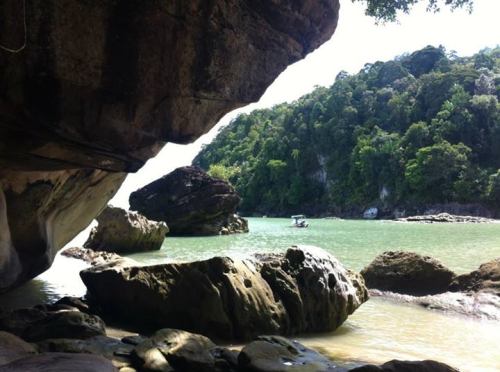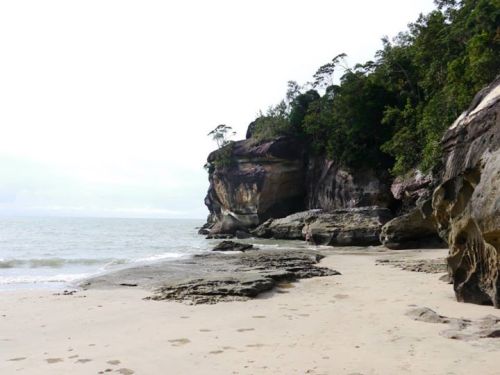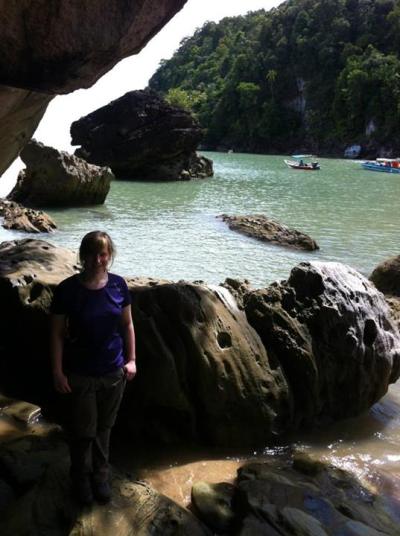Bako National Park, Sarawak
by Amy & the world
I have mixed memories of Bako National Park. On the one hand, it was probably the most beautiful place I’ve been lucky enough to visit. On the other, it did give me a distrust of monkeys – or at least macaques – after one made a leaped onto our table and made off with my much-needed chicken leg dinner.
One thing’s for certain: it knows how to make – and leave – an impression (generally for the right reasons).
Getting to Bako
First thing’s first, you need to get to the Park. Although quicker to grab a taxi or hire a mini-bus with a group, the public buses are by far the cheapest way to get there at RM3.50 one way (around 65p) – and they still only take 35-45 minutes from Kuching (catch it towards the end of Jalan Bazaar/further from the bus station and you’ll save yourself a bit of time). They come once an hour.
However road transport can only take you so far and you’ll be dropped at Kampung Bako. From there, visit the ticketing office to charter a boat to take you on the 30-minute journey to the National Park, past stilt-houses rising out of the water, fishermen, foliage-covered mountains (I told you Bako knows how to make an impression).
Boats cost just under RM50 – about £9 – return. They can fit up to five people so the cheapest thing to do is club up with others on your bus to share one. However your boat driver will ask you for a return journey time so you need to make sure the others on your boat have similar plans for their trip to you. For a bit more flexibility, go it alone (or at least, alone in your group).
Also check the tides before you go – or at least take some waterproof sandals. Although we got dropped off at the National Park’s jetty, the time we wanted to go back happened to be low tide, so the boats couldn’t get up to it. Instead we were picked from the park beach – well, the sea by it. Trousers rolled and bags held above us, we waded back to our boat through the (Singapore bath warm) water and dried our legs in the sun as we were taken back to the bus stop – it may not be glamorous, but it was certainly a memorable way to leave!
To stay or not to stay
If you’re short on time – or not too bothered about undertaking lots of treks – Bako can be done in a day. Get one of the earliest buses from Kuching and ask your boat driver when the latest is that they’ll pick you up.
But I’d highly recommend an overnight stay. The accommodation is basic and the food isn’t anything to write home about (and that’s if it doesn’t get stolen by cheeky macaques). But it really allows you to make the most of your time in the Park. You can relax with a drink in-between walks, watch the sun set over the beach at park HQ or get up early and enjoy one of the trails before the next day’s visitors really get going.
You can also go on their night trails for a small fee, where a guide will point out wildlife you might not see during the day. We were exhausted and didn’t, but part of me regrets that decision now.
We booked our accommodation online and confirmed our reservation with the Kuching tourist office when we arrived in the city. Despite this, we did have some problems on checking in, the people working at the Park HQ reception seemingly not being able to find our reservation. However they did honor it. So I’d recommended taking a print-out of your reservation and also phoning to confirm – at least then you know a room should be allocated to you, even if they’re not sure quite where you’re supposed to be saying. This all said, it looked like we were the only people having trouble so I don’t think ours was a common experience – don’t let it put you off!
Treks and trails
On arriving at the Park headquarters, you receive a paper map detailing the 17 walks on offer. This includes a list of how long they are and a rough idea of how long they should take to complete one way. I’ll admit it, we had a good chuckle at that at first. 45 minutes to go 1km? Maybe for someone who’s seriously out of shape…
Turns out, the people who put that map together know what they’re talking about. The trails may not be particularly long, but on many of the routes you’ll find yourself clambering over, up and down steep paths laden with tree roots and rocks. You’re also in the middle of a hot, sticky jungle. And let’s not forget that occasionally you might want to stop to look at some of the plants, wildlife or stunning views (or just to catch your breath and have some water – though I highly recommend a Platypus or similar).
Don’t be put off by this though – we’re of average fitness and probably found the heat and humidity the hardest element to deal with, rather than the treks themselves being hugely difficult. If you’re not a confident walker, you could pack a walking pole (I am a huge fan of walking poles). But there were plenty of people do the trails in flip flops and – in some cases – swimming costumes. I wouldn’t recommend following their example, mind.
There are also some slightly easier trails too; the first one we undertook, to Telok Delima, was often along boardwalk and mostly flat. The park guides at reception should be able to offer advice if you’re not sure what will suit your fitness levels.
And the trails may have been tiring, but absolutely worth it. I’ll let the photos in this entry speak for themselves as to why.
What else is there to do
Not content trekking through mangroves and spectacular jungle or relaxing on stunning, secluded beaches? The Park also has an abundance of wildlife. As well as the macaques, we also saw Proboscis monkeys (best looking animals ever?) and silver leaf monkeys also call the area their home. The Park HQ and nearby beach are home to bearded pigs, who you might see snuffling around the cabins or snoozing in the shade. And then there’s the many other insects and small mammals that you might spot. We saw some groups on trips with guides who were pointing out these animals to them, so if you’re a wildlife buff then this could be a worthwhile investment.
In short…
If you’re visiting Kuching, Bako National Park is a must-visit. It’s hard to describe how visiting here makes you feel. I haven’t made it sound like a hugely relaxing experience and yet, despite the sweat, the stickiness, the tricky trails, it somehow is. Probably something to do with getting to the end of a trek and being greeted by almost-empty beaches surrounded by tropical trees, with views of endless water or mountains rising from the sea. Simply breathtaking. (I told you it left an impression!)
Just make sure you eat your dinner inside – or at least away from the sides of the canteen!














